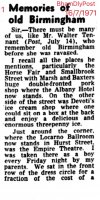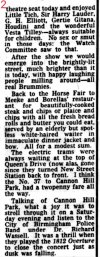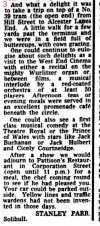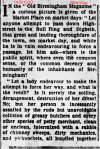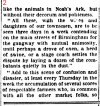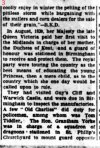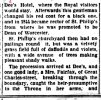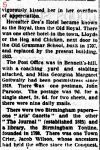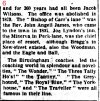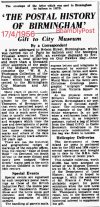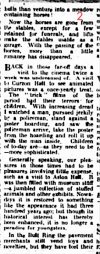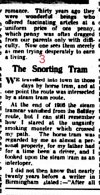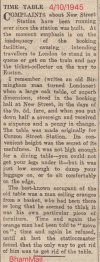-
Welcome to this forum . We are a worldwide group with a common interest in Birmingham and its history. While here, please follow a few simple rules. We ask that you respect other members, thank those who have helped you and please keep your contributions on-topic with the thread.
We do hope you enjoy your visit. BHF Admin Team
You are using an out of date browser. It may not display this or other websites correctly.
You should upgrade or use an alternative browser.
You should upgrade or use an alternative browser.
Memories : Trip down Birmingham memory lane
- Thread starter Vivienne14
- Start date
Richard Dye
master brummie
Unfortunately, days gone forever!I have created this thread so that we can record any past written records giving the author’s views of Birmingham streets and places of the past.
First up
View attachment 160722
View attachment 160724
View attachment 160723
Source: British Newspaper Archive
Eric Gibson
master brummie
A lot of rose tinted glasses there though I think, the average factory worker would have seen little of that.
A reminder about the purpose of this thread:
I have created this thread so that we can record any past written records giving the author’s views of Birmingham streets and places of the past.
I’d appreciate if members could keep to the thread topic please. Many thanks.
Viv.
I have created this thread so that we can record any past written records giving the author’s views of Birmingham streets and places of the past.
I’d appreciate if members could keep to the thread topic please. Many thanks.
Viv.
Richard Dye
master brummie
When I was growing up in the 50,s on Radnor Rd. Being quite close to Handsworth Park, I used to love going to the annual flower show. It was inexpensive (or I would have been able to go), or maybe because I belonged to St Mary’s 120th scout troop. It was more than flowers, it was vegetables Morris dancing and all sorts of stuff. There were lots of people, it was in the summertime and always a great couple of days. I remember also being amazed a how quickly all of the flowers and tents went away! I have read where the park went into disrepair, I hope that the park is back to what I remember for folks to enjoy!
daithelife
proper brummie kid
I left Birmingham back in the early 1960's and for all sorts of reasons have not returned at all until very recently. What on earth can I say? Talk about a stranger in a strange land. Nothing was recognisable. The city and suburbs I knew as a youngster have not only vanished but have disappeared so completely as to leav me doubting whether or not they ever existed.
I came to see where I had grown up. Unfortunately, although I could see me my Gran's house where I was born, my first home in Aston where my parents were placed after being bombed out has apparently long since gone and now lies somewhere under Spaghetti Junction. However the house I grew up in the quite side roads off the Bristol Road in Longbridge is still there. However it is now a security fenced bastion of middle-class insecurity. Where once we neighbourhood kids used to sit on the low walls and chatter there are quite literally security fences and electric gates protecting those within and their shiny cars.
So much for where I lived lets cross the Bristol Road and wander down Tessall Lane to the bridge over the river (Stream) by the railway track and the wild patch of land behind Kalamazoo where we used to watch steam trains as smaller boys and play our first clumsy attempts at tonsil hockey when we got older. What used to be so quiet is now a huge railway station. Presumably to serve the "Orstin" as we used to know the huge car works. But all that is gone replaced by futuristic blocks like the architect had a Lego fetish. Of course I knew Austin or Rover or whatever had gone, I had not expected it to be obliterated.
Hey Ho, off we go to Northfield. In my memory a sleepy town I walked through on my way to St Laurence's School with its awful outside toilets. The Church and the pound with its strange stone still remain. How we all wondered at school did a stone get into so much trouble it had to be locked up! The Northfield I knew was a grubby sort of place but it was just the grime that seemed to be everywhere in those days. It was otherwise well kept and litter free with interesting little shops and a decent sized Woolworths and two pubs, to show it was a place of some importance. In my time I remember a forge where the odd horse was still shod. Now it seems to have all been replaced by a huge centre that strangely seems to actually sell very little. Odd really, what is it for, who does it serve.
OK. I'll add more later if anyone is interested and continue my journey to a city centre which was so unrecognisable I knew not where I was.
I came to see where I had grown up. Unfortunately, although I could see me my Gran's house where I was born, my first home in Aston where my parents were placed after being bombed out has apparently long since gone and now lies somewhere under Spaghetti Junction. However the house I grew up in the quite side roads off the Bristol Road in Longbridge is still there. However it is now a security fenced bastion of middle-class insecurity. Where once we neighbourhood kids used to sit on the low walls and chatter there are quite literally security fences and electric gates protecting those within and their shiny cars.
So much for where I lived lets cross the Bristol Road and wander down Tessall Lane to the bridge over the river (Stream) by the railway track and the wild patch of land behind Kalamazoo where we used to watch steam trains as smaller boys and play our first clumsy attempts at tonsil hockey when we got older. What used to be so quiet is now a huge railway station. Presumably to serve the "Orstin" as we used to know the huge car works. But all that is gone replaced by futuristic blocks like the architect had a Lego fetish. Of course I knew Austin or Rover or whatever had gone, I had not expected it to be obliterated.
Hey Ho, off we go to Northfield. In my memory a sleepy town I walked through on my way to St Laurence's School with its awful outside toilets. The Church and the pound with its strange stone still remain. How we all wondered at school did a stone get into so much trouble it had to be locked up! The Northfield I knew was a grubby sort of place but it was just the grime that seemed to be everywhere in those days. It was otherwise well kept and litter free with interesting little shops and a decent sized Woolworths and two pubs, to show it was a place of some importance. In my time I remember a forge where the odd horse was still shod. Now it seems to have all been replaced by a huge centre that strangely seems to actually sell very little. Odd really, what is it for, who does it serve.
OK. I'll add more later if anyone is interested and continue my journey to a city centre which was so unrecognisable I knew not where I was.
Richard Dye
master brummie
Viv, a very good history lesson!Looking back a century later at 1830s Birmingham. Viv.
View attachment 160749View attachment 160750View attachment 160751View attachment 160752
View attachment 160754
View attachment 160753
Source: British Newspaper Archive
I noticed the cost of posting a letter seemed abnormally high, am I missing something. Can anyone shed a light on that ?
daithelife
proper brummie kid
Richard, prior to the introduction of the 'penny' post in 1840 the cost of sending a letter depended upon size, weight and distance travelled. Letters sent via the Post Office were generally paid for by the recipient not the sender and were proportionately much more expensive than today. Typically the cost from Birmingham to Glasgow could be as much as one penny a sheet. Important documents sent prepaid were much more expensive as they had to be seen to be delivered to the named recipient (troublesome indeed in those days of formal etiquette) and I can only assume that this is what is meant in this article.
daithelife
proper brummie kid
Further research has led me to the postal museum who indicate that postage of a one ounce missive from London to Edinburgh would have cost four shillings and four pence in 1812. This would be the equivalent today of £20.86p!!!
Richard Dye
master brummie
Add Facebook to that!If only those posting their rubbish on Instagram had to pay something like this

